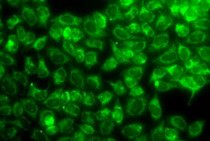anti-USP10 antibody
CAT.NO. : ARG59869
US$ Please choose
US$ Please choose
Size:
Trail, Bulk size or Custom requests Please contact us
概述
| 产品描述 | Rabbit Polyclonal antibody recognizes USP10 |
|---|---|
| 反应物种 | Hu, Ms |
| 应用 | ICC/IF, WB |
| 宿主 | Rabbit |
| 克隆 | Polyclonal |
| 同位型 | IgG |
| 靶点名称 | USP10 |
| 抗原物种 | Human |
| 抗原 | Recombinant fusion protein corresponding to aa. 499-798 of Human USP10 (NP_005144.2). |
| 偶联标记 | Un-conjugated |
| 別名 | Deubiquitinating enzyme 10; Ubiquitin thioesterase 10; UBPO; Ubiquitin-specific-processing protease 10; Ubiquitin carboxyl-terminal hydrolase 10; EC 3.4.19.12 |
应用说明
| 应用建议 |
| ||||||
|---|---|---|---|---|---|---|---|
| 应用说明 | * The dilutions indicate recommended starting dilutions and the optimal dilutions or concentrations should be determined by the scientist. |
属性
| 形式 | Liquid |
|---|---|
| 纯化 | Affinity purified. |
| 缓冲液 | PBS (pH 7.3), 0.02% Sodium azide and 50% Glycerol. |
| 抗菌剂 | 0.02% Sodium azide |
| 稳定剂 | 50% Glycerol |
| 存放说明 | For continuous use, store undiluted antibody at 2-8°C for up to a week. For long-term storage, aliquot and store at -20°C. Storage in frost free freezers is not recommended. Avoid repeated freeze/thaw cycles. Suggest spin the vial prior to opening. The antibody solution should be gently mixed before use. |
| 注意事项 | For laboratory research only, not for drug, diagnostic or other use. |
生物信息
| 数据库连接 | Swiss-port # P52479 Mouse Ubiquitin carboxyl-terminal hydrolase 10 Swiss-port # Q14694 Human Ubiquitin carboxyl-terminal hydrolase 10 |
|---|---|
| 基因名称 | USP10 |
| 全名 | ubiquitin specific peptidase 10 |
| 背景介绍 | Ubiquitin is a highly conserved protein that is covalently linked to other proteins to regulate their function and degradation. This gene encodes a member of the ubiquitin-specific protease family of cysteine proteases. The enzyme specifically cleaves ubiquitin from ubiquitin-conjugated protein substrates. The protein is found in the nucleus and cytoplasm. It functions as a co-factor of the DNA-bound androgen receptor complex, and is inhibited by a protein in the Ras-GTPase pathway. The human genome contains several pseudogenes similar to this gene. Several transcript variants, some protein-coding and others not protein-coding, have been found for this gene. [provided by RefSeq, Jan 2013] |
| 生物功能 | Hydrolase that can remove conjugated ubiquitin from target proteins such as p53/TP53, BECN1, SNX3 and CFTR. Acts as an essential regulator of p53/TP53 stability: in unstressed cells, specifically deubiquitinates p53/TP53 in the cytoplasm, leading to counteract MDM2 action and stabilize p53/TP53. Following DNA damage, translocates to the nucleus and deubiquitinates p53/TP53, leading to regulate the p53/TP53-dependent DNA damage response. Component of a regulatory loop that controls autophagy and p53/TP53 levels: mediates deubiquitination of BECN1, a key regulator of autophagy, leading to stabilize the PIK3C3/VPS34-containing complexes. In turn, PIK3C3/VPS34-containing complexes regulate USP10 stability, suggesting the existence of a regulatory system by which PIK3C3/VPS34-containing complexes regulate p53/TP53 protein levels via USP10 and USP13. Does not deubiquitinate MDM2. Deubiquitinates CFTR in early endosomes, enhancing its endocytic recycling. [UniProt] |
| 细胞定位 | Cytoplasm. Nucleus. Early endosome. Note=Cytoplasmic in normal conditions (PubMed:20096447). After DNA damage, translocates to the nucleus following phosphorylation by ATM (PubMed:20096447). [UniProt] |
| 预测分子量 | 87 kDa |
| 翻译后修饰 | Phosphorylated by ATM following DNA damage, leading to stablization and translocation it to the nucleus. Ubiquitinated. Deubiquitinated by USP13. [UniProt] |
 New Products
New Products





















